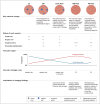Advances in Understanding Hepatocellular Carcinoma Vasculature: Implications for Diagnosis, Prognostication, and Treatment
- PMID: 39344546
- PMCID: PMC11444852
- DOI: 10.3348/kjr.2024.0307
Advances in Understanding Hepatocellular Carcinoma Vasculature: Implications for Diagnosis, Prognostication, and Treatment
Abstract
Hepatocellular carcinoma (HCC) progresses through multiple stages of hepatocarcinogenesis, with each stage characterized by specific changes in vascular supply, drainage, and microvascular structure. These vascular changes significantly influence the imaging findings of HCC, enabling non-invasive diagnosis. Vascular changes in HCC are closely related to aggressive histological characteristics and treatment responses. Venous drainage from the tumor toward the portal vein in the surrounding liver facilitates vascular invasion, and the unique microvascular pattern of vessels that encapsulate the tumor cluster (known as a VETC pattern) promotes vascular invasion and metastasis. Systemic treatments for HCC, which are increasingly being used, primarily target angiogenesis and immune checkpoint pathways, which are closely intertwined. By understanding the complex relationship between histopathological vascular changes in hepatocarcinogenesis and their implications for imaging findings, radiologists can enhance the accuracy of imaging diagnosis and improve the prediction of prognosis and treatment response. This, in turn, will ultimately lead to better patient care.
Keywords: Angiogenesis; Hepatocarcinogenesis; Hepatocellular carcinoma; Systemic therapy; Vascular invasion.
Copyright © 2024 The Korean Society of Radiology.
Conflict of interest statement
The authors have no potential conflicts of interest to disclose.
Figures







Similar articles
-
Noninvasive imaging of hepatocellular carcinoma: From diagnosis to prognosis.World J Gastroenterol. 2018 Jun 14;24(22):2348-2362. doi: 10.3748/wjg.v24.i22.2348. World J Gastroenterol. 2018. PMID: 29904242 Free PMC article. Review.
-
Radiomics Model of Dynamic Contrast-Enhanced MRI for Evaluating Vessels Encapsulating Tumor Clusters and Microvascular Invasion in Hepatocellular Carcinoma.Acad Radiol. 2025 Jan;32(1):146-156. doi: 10.1016/j.acra.2024.07.007. Epub 2024 Jul 18. Acad Radiol. 2025. PMID: 39025700
-
Imaging features based on Gd-EOB-DTPA-enhanced MRI for predicting vessels encapsulating tumor clusters (VETC) in patients with hepatocellular carcinoma.Br J Radiol. 2021 Mar 1;94(1119):20200950. doi: 10.1259/bjr.20200950. Epub 2021 Jan 20. Br J Radiol. 2021. PMID: 33417489 Free PMC article.
-
Vessels Encapsulating Tumor Clusters (VETC) Is a Powerful Predictor of Aggressive Hepatocellular Carcinoma.Hepatology. 2020 Jan;71(1):183-195. doi: 10.1002/hep.30814. Epub 2019 Aug 9. Hepatology. 2020. PMID: 31206715
-
Hepatocelluar nodules in liver cirrhosis: hemodynamic evaluation (angiography-assisted CT) with special reference to multi-step hepatocarcinogenesis.Abdom Imaging. 2011 Jun;36(3):264-72. doi: 10.1007/s00261-011-9685-1. Abdom Imaging. 2011. PMID: 21267562 Free PMC article. Review.
Cited by
-
Bioinformatics analysis and experimental validation of C6orf120 as a potential prognostic marker and therapeutic target for liver hepatocellular carcinoma.Biomol Biomed. 2025 Mar 7;25(4):925-939. doi: 10.17305/bb.2024.11246. Biomol Biomed. 2025. PMID: 39388711 Free PMC article.
-
Construction of nomogram model based on contrast-enhanced ultrasound parameters to predict the degree of pathological differentiation of hepatocellular carcinoma.Front Oncol. 2025 Jan 27;15:1519703. doi: 10.3389/fonc.2025.1519703. eCollection 2025. Front Oncol. 2025. PMID: 39931079 Free PMC article. Review.
-
Spectral computed tomography parameters for predicting vessels encapsulating tumor clusters (VETC) pattern in hepatocellular carcinoma: a pilot study.Quant Imaging Med Surg. 2025 Apr 1;15(4):3285-3297. doi: 10.21037/qims-24-2077. Epub 2025 Mar 28. Quant Imaging Med Surg. 2025. PMID: 40235763 Free PMC article.
-
Demonstration of Hepatic Vein Abnormalities Using Contrast-Enhanced Sonography in Liver Diseases.Diagnostics (Basel). 2025 Mar 12;15(6):709. doi: 10.3390/diagnostics15060709. Diagnostics (Basel). 2025. PMID: 40150052 Free PMC article. Review.
References
-
- Rumgay H, Ferlay J, de Martel C, Georges D, Ibrahim AS, Zheng R, et al. Global, regional and national burden of primary liver cancer by subtype. Eur J Cancer. 2022;161:108–118. - PubMed
Publication types
MeSH terms
Grants and funding
LinkOut - more resources
Full Text Sources
Medical

